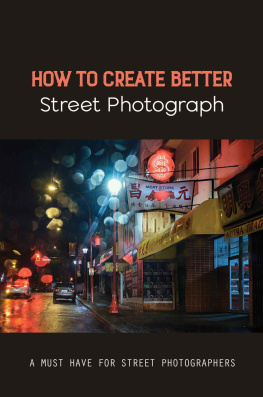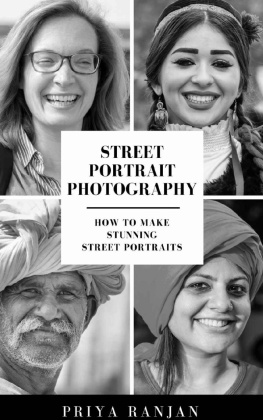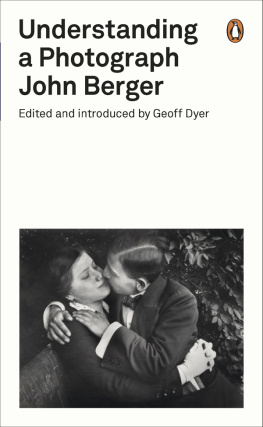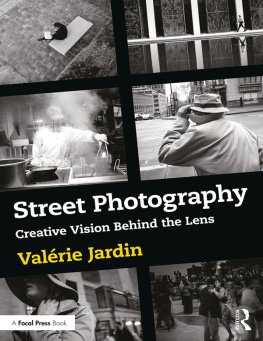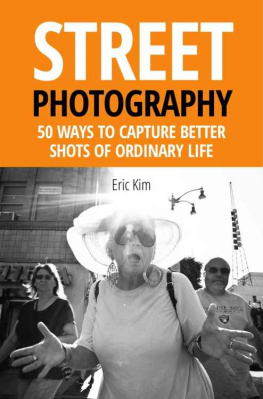Street
Photography
The Art of Capturing the Candid Moment
Gordon Lewis

Gordon Lewis
gordon.lewis.mail@gmail.com
shutterfinger.typepad.com
shutterfinger.zenfolio.com
etsy.com/shop/ShutterfingerPhoto
Project Editor: Maggie Yates
Copyeditor: Maggie Yates
Layout: Petra Strauch
Cover Design: Helmut Kraus, www.exclam.de
Printer: Friesens Corporation
Printed in Canada
ISBN 978-1-937538-37-8
1st Edition 2015
2015 Gordon Lewis
Rocky Nook, Inc.
802 E. Cota Street, 3rd Floor
Santa Barbara, CA 93103
www.rockynook.com
Library of Congress Cataloging-in-Publication Data
Lewis, Gordon, 1953-
Street photography : the art of capturing the candid moment / Gordon Lewis. -- 1st edition.
pages cm
ISBN 978-1-937538-37-8 (softcover : alk. paper)
1. Street photography. I. Title.
TR659.8.L49 2015
778.94--dc23
2014048710
All rights reserved. No part of the material protected by this copyright notice may be reproduced or utilized in any form, electronic or mechanical, including photocopying, recording, or by any information storage and retrieval system, without written permission of the publisher.
Many of the designations in this book used by manufacturers and sellers to distinguish their products are claimed as trademarks of their respective companies. Where those designations appear in this book, and Rocky Nook was aware of a trademark claim, the designations have been printed in caps or initial caps. All product names and services identified throughout this book are used in editorial fashion only and for the benefit of such companies with no intention of infringement of the trademark. They are not intended to convey endorsement or other affiliation with this book.
While reasonable care has been exercised in the preparation of this book, the publisher and author(s) assume no responsibility for errors or omissions, or for damages resulting from the use of the information contained herein or from the use of the discs or programs that may accompany it.
This book is printed on acid-free paper.
Photo enthusiast, Quito, Ecuador 2010
Foreword
This book is the result of over 40 years of practice as a dedicated street photographer. My interest in this photographic genre began in the late 1960s, when I was a student in high school, before I was even aware that such a thing as street photography existed. I simply felt moved to take candid pictures of people and things that interested me, wherever I might happen to find them. This interest continued during my undergraduate years at Harvard, when I became aware that there were master photographers who shared the same inspiration and passionphotographers such as Henri Cartier-Bresson, Elliott Erwitt, Roy deCarava, and Gordon Parks. From them and their work I drew deeper inspiration, insight, and encouragement. This passion for capturing candid expressions of life continued through the 80s and 90s, when I lived in Los Angeles, a city where pedestrians and their habitats are few and far between. The introduction of digital photography and a move to Philadelphia, as fine a city for street photographers as one can hope to find, gave me new subjects and a new digital medium with which to capture them. My desire to share my work and thoughts with a larger audience inspired me to launch Shutterfinger, a blog about photography. Precipitation (), a photo I published on a different blog (The Online Photographer), attracted the attention of George Barr, who included it in his book, Why Photographs Work (Rocky Nook, 2010). This photo caught the eye of Rocky Nooks publisher, Gerhard Rossbach, who asked if I would be interested in writing a book on street photography.
To be honest, I wasnt sure Id be able to muster the sustained effort it would take to pull off an entire book. I write full-time for a living, so the idea of adding to my writing load (as well as time spent sitting in front of a computer) was not instantly appealing. The common doubts, fears, and insecurities involved with writing a book also contributed to my reluctance. The realization that this would probably be my only opportunity to publish my work for a broad audience motivated my decision to go for it, despite my doubts. I hope youll enjoy the following work as much as I enjoyed producing it. I hope these photographs inspire you to try, enjoy, practice, and improve your own street photography. May the only limit to the amazing photographs you will capture be the time and interest you have in capturing them.
Acknowledgements
Thanks to Mike Johnston for The Online Photographer; George Barr for Why Photographs Work; Gerhard Rossbach, Matthias Rossmanith, and Maggie Yates for their patience, persistence, and good humor; Dean Collins (RIP) for opening my eyes to lighting and color; Colin Sprang for teaching me darkroom basics; Ned Bunnell and Chuck Westfall for access to pro equipment; Steve Barnes and Darnell Gadberry for their continued friendship; and most especially my wife, Claudia, for her continuing love and support.
Chapter 1
The Allure of Street Photography
People have been practicing street photography for practically as long as there have been cameras and streets. Although its popularity has risen, fallen, and risen again over the decades, street photography has never disappeared completely. In fact, digital imaging has made street photography as popular (at least among photographers) as it has ever been. For some photographers however, the reasons behind this popularity are a mystery: some may wonder why anyone would want to wander the streets photographing random strangers without their knowledge or permission, and whether the results are worth the effort. This chapter will not try to convince anyone who has no interest in street photography why they should embrace it. After all, its a big world and there are plenty of other subjects and styles to explore. You should do whatever you love most. This chapter is instead for the curious. It explores why so many photographers love street photographyand why, if youve never done it before, you might want to try it for yourself.
Its Easy
What better and easier time to practice street photography than now? Cameras are built into cell phones that anyone can carry everywhere, all the time. Dedicated cameras are available in practically every size, weight, and configuration you like at a wide range of prices. Better yet, all you really need is a camera and a lens. Anything else is not only optional, but often a hindrance.
Most cameras have the ability to handle focus or exposure automatically. Is the image a little too light, too dark, or blurry? Youll be able to tell immediately, and depending on what type of camera and settings youre using, correct the exposure after the fact. You can shoot literally thousands of images and store them on something thats not much larger than a postage stamp. Once you have all the basic equipment you needcamera, lens, memory card, computer, software, etc.the incremental cost is practically nil. Thats important when youre practicing an art where even the best photographers take a large number of images in the pursuit of capturing that one fascinating moment.


